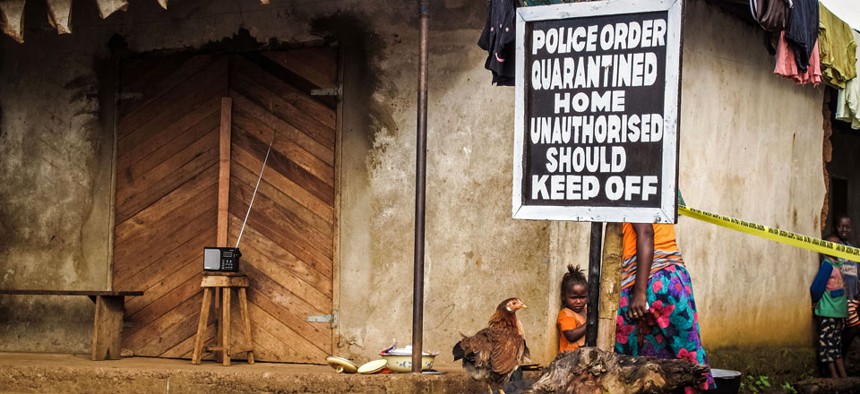Geospatial Agency Goes Unclassified for Ebola Effort

A child, center, stands underneath a signboard reading 'Police order quarantined home unauthorised should keep off' as a family home is placed under quarantine due to the Ebola virus in Port Loko, Sierra Leone. Michael Duff/AP
The online Ebola tools the agency is offering NGOs provide much more dynamic capabilities than those previously deployed by the agency.
The National Geospatial-Intelligence Agency has launched a public website, featuring unclassified geospatial imagery and tools, to aid U.S. and international efforts to combat the spread of Ebola in West Africa.
The agency has turned its powerful capabilities over to unclassified disaster-relief work before, including after Typhoon Haiyan, which devastated the Philippines last November.
But the online Ebola tools the agency is offering nongovernmental organizations and other relief agencies provide much more dynamic mapping capabilities than the agency has previously deployed in an unclassified setting.
“The level at which we are trying to expose our data and commercial imagery products is unprecedented,” said Martin Cox, national geospatial-intelligence officer for Africa who’s leading NGA’s Ebola response, in an agency release. “If they are trying to do good, why would we not want to help?”
The first draft of the new mapping tools contains data on the disease’s outbreak specifically in Guinea. That includes constantly updated data on Ebola cases overlaid with other data on cultural landmarks, power grids, and communications and transportation infrastructure.
Users can pinpoint Ebola cases by area and their approximate locations to hospitals and airfields based on both publicly released NGA data and open source data.
In its previous disaster-relief work, NGA would only provide static “snapshots” of relevant data, according to NGA corporate communications.
But with the multitude of NGOs and other outside groups working on the crisis, the agency decided to take a different tack.
“If we don’t keep it unclassified, the majority of the people who are working in the field will not be able to access the information that they may need to help bring this epidemic to a close,” Cox said.
The site uses the ArcGIS Platform from geographic mapping software provider ESRI and is hosted in the cloud by Amazon Web Services.


